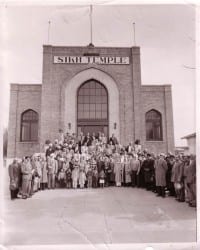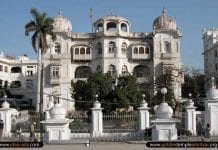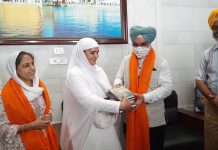


STOCKTON, California—Quietly, politely, deferentially, Manjit Singh Uppal said, “This has been my home since 1973. As a little boy, it felt like a playground.”
Uppal, 52 and a former temple president, lives in Lodi now. But Stockton Gurdwara Sahib is still home.
The temple, at the far end of South Grant Street, also is home to thousands of Sikhs on the West Coast. For them, it represents an almost-mystical place deserving of pilgrimage, reverence and historical study.
This fall, Stockton Gurdwara Sahib celebrates a century of history, some of it surprising:
» It is oldest temple in the United States; the birthplace of Sikhism in America.
» It has a direct link to Indian independence and was home to the Ghadar (Revolution) Party, which agitated for a free, independent and united India four decades before that status was achieved in 1950. Sikhs describe Stockton as “ground zero for India’s independence struggle.”
» America’s first Punjabi-language newspaper was published by the Ghadar Party and financed by Stockton Sikhs.
» Bhagat Singh Thind, a civil rights pioneer and the first Sikh to serve in the U.S. Army (during World War I), was a member of Stockton Gurdwara.
» Starting in 1957, Democrat Dalip Singh Saund served three terms in the House of Representatives. He was the first Asian, Indian and Sikh elected to Congress. Before that, he was secretary of Stockton Gurdwara.
For many, the compound on South Grant – which will be renamed Sikh Temple Street on Jan. 1 – is hallowed ground.
Vancouver, B.C., also has a rich history of Sikhism, but not like Stockton’s.
Harinder Randhawa, a 52-year-old hospital dietitian in Vancouver, was touring Gurdwara Sahib earlier this week on a visit to the United States.
“This is our temple,” she said. “It’s very historic. I feel so proud to walk where the first settlers walked.
“I can see here the fruit of their hard work and suffering and sacrifice. This is our heritage. I can go home and tell my people, ‘I saw the history.’ ”
The Stockton Gurdwara has 5,000 Northern Californians who call it home, even though larger, more elaborate temples have been built in Yuba City, San Jose and El Sobrante.
“There are many reasons,” said Bhajan Singh Bhinder, coordinator of the local centennial committee. “The pioneers came here; we had the first settlement; fighting for civil rights in America happened here. The freedom struggle for India began from here. This place is so unique. It deserves the attention it’s getting.”
Two years ago, organizers started digging more deeply into the temple’s past. They discovered journals and ledger books from the early 20th century. College students have spent the summer painstakingly taking photographs of yellow and dog-eared pages written decades ago. They have worked out of a closet-sized room on the temple’s back side. The original ledger books are kept inside a safe almost as large as the room itself.
“I wanted to help shape the Sikh identity in America,” said 19-year-old volunteer Rajan Gill of Yuba City. The University of California, Davis, senior is a cousin of Lodi’s Ricky Gill, who at 25 is running as a Republican for California’s 9th Congressional District seat.
The Sikhs, a proud people, celebrate those kinds of relationships – alongside their 100 years of tolerance and faith in America.
“And this is the place where people come to see that,” Bhinder said. “It is more important than ever that Americans go to each other’s places of worship and homes and celebrations.
“That’s the best way to be a united nation.”
Beginning this weekend, the local Sikh community is hosting several weeks of activities acknowledging its rich heritage in Stockton.
It starts this morning with a first-of-its-kind conference – “The Sikh Journey in America” – inside the Faye Spanos Concert Hall at the University of the Pacific.
It culminates Oct. 14 with the second day of a two-day grand finale, complete with parade, food, booths and entertainment.
Organizers expect huge crowds from all over Northern California. They’ve worked hard to commemorate the past on a large scale.
After the academic events are over and the parade crowds have gone home, the Gurdwara Sahib and its members will still congregate on the sacred ground that has been theirs for 100 years.
“Only a few have been here longer than I have,” Uppal said. “This is it for me. This is where I will die.”




